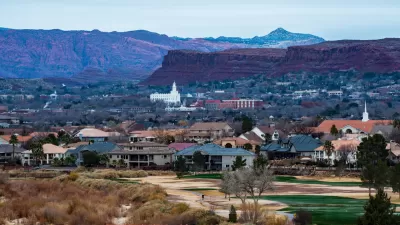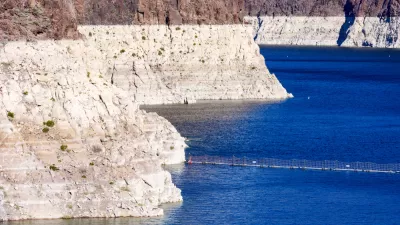Officials in the Coachella Valley seem reluctant to restrict water supplies to the many golf courses and ornamental lakes that dot the region, opting instead to cut water deliveries to a groundwater recharge facility.

When cities like Palm Springs first sprang up in the Southern California desert, the possibilities for growth seemed limitless. As Ian James explains in the Los Angeles Times, “The entrepreneurs and boosters who decades ago built the Coachella Valley’s reputation as a playground destination saw the appeal of developments awash in water, made possible by wells drawing on the aquifer and a steady stream of Colorado River water.”
But with the Colorado River at record low levels and groundwater supplies growing short, the region may need to shift its priorities. Sendy Hernández Orellana Barrows, president of the CactusToClouds Institute, “believes becoming more climate-resilient will require making better use of water by prioritizing drinking water for communities and reducing consumption that isn’t vital.” Yet local leaders have opted to cut groundwater replenishment rather than put any restrictions on golf courses, farmland, or artificial lakes.
According to James, “the water district’s managers anticipate securing the bulk of the reductions by curtailing water deliveries to a groundwater replenishment facility in La Quinta, where Colorado River water pours into ponds and percolates into the soil to recharge the aquifer.” Cástulo Estrada, vice president of the water district’s board, calls the plan “the easiest way, the less disruptive way” to temporarily cut back on water use. Meanwhile, critics like Hernández Orellana say future sustainability “demands switching to much lower water use” from all sectors.
FULL STORY: Why desert golf courses and artificial lakes remain untouched by the Colorado River crisis

Study: Maui’s Plan to Convert Vacation Rentals to Long-Term Housing Could Cause Nearly $1 Billion Economic Loss
The plan would reduce visitor accommodation by 25% resulting in 1,900 jobs lost.

Alabama: Trump Terminates Settlements for Black Communities Harmed By Raw Sewage
Trump deemed the landmark civil rights agreement “illegal DEI and environmental justice policy.”

Why Should We Subsidize Public Transportation?
Many public transit agencies face financial stress due to rising costs, declining fare revenue, and declining subsidies. Transit advocates must provide a strong business case for increasing public transit funding.

Paris Bike Boom Leads to Steep Drop in Air Pollution
The French city’s air quality has improved dramatically in the past 20 years, coinciding with a growth in cycling.

Why Housing Costs More to Build in California Than in Texas
Hard costs like labor and materials combined with ‘soft’ costs such as permitting make building in the San Francisco Bay Area almost three times as costly as in Texas cities.

San Diego County Sees a Rise in Urban Coyotes
San Diego County experiences a rise in urban coyotes, as sightings become prevalent throughout its urban neighbourhoods and surrounding areas.
Urban Design for Planners 1: Software Tools
This six-course series explores essential urban design concepts using open source software and equips planners with the tools they need to participate fully in the urban design process.
Planning for Universal Design
Learn the tools for implementing Universal Design in planning regulations.
Smith Gee Studio
Alamo Area Metropolitan Planning Organization
City of Santa Clarita
Institute for Housing and Urban Development Studies (IHS)
City of Grandview
Harvard GSD Executive Education
Toledo-Lucas County Plan Commissions
Salt Lake City
NYU Wagner Graduate School of Public Service





























